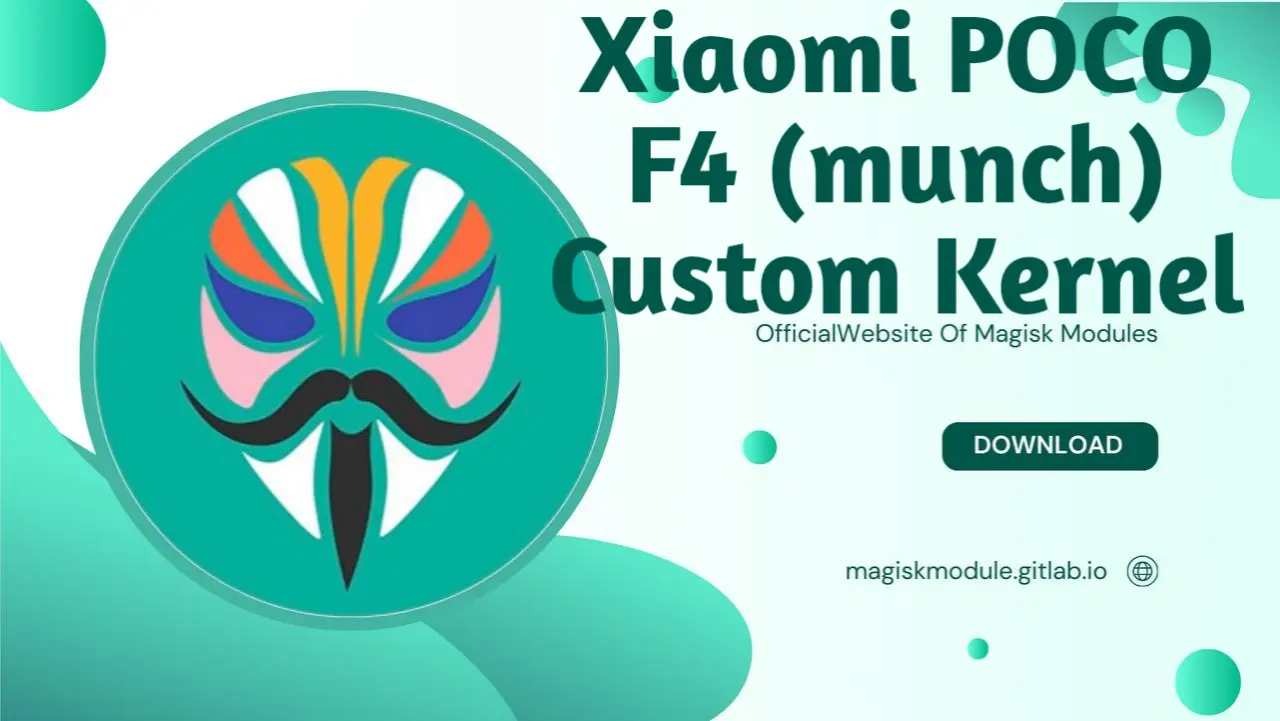Xiaomi POCO F4 (munch) Custom Kernel

Xiaomi POCO F4 (Munch) Custom Kernel – Boost Performance and Battery Life
For Xiaomi POCO F4 (Munch) users, the potential for high-end performance and efficiency is unlocked with custom kernels. By replacing the stock kernel with a custom kernel, you gain access to a range of features designed to improve performance, battery life, and system stability. A well-optimized custom kernel not only enhances your POCO F4’s multitasking and gaming experience but also provides advanced control over CPU, GPU, thermal management, and power consumption.
Got a Xiaomi POCO F4 (Munch) and want to know the secret to turbocharging its performance? We’re about to spill the beans on custom kernels - what they are, how to get them, and how to customize them for maximum benefits. Buckle up, because this guide is about to take your device from sluggish to supercharged, and leave all your friends wondering how you did it.
Why Install a Custom Kernel on Xiaomi POCO F4 (Munch)?
Custom kernels unlock enhanced control over your POCO F4’s system hardware, allowing for a customized experience. Installing a custom kernel can supercharge your system in many ways, chief among them…
Improved Performance: Custom kernels typically allow for increased CPU and GPU speeds, faster app loading times, and a smoother gaming experience.
Extended Battery Life: Optimized settings in custom kernels reduce power consumption during standby and active use.
Thermal Efficiency: Enhanced thermal management prevents overheating, ensuring device longevity.
Better RAM Management: By tightening up memory allocation, custom kernels can effortlessly support simultaneous tasks, taking multitasking to the next level.
Advanced Tweaks: Users gain control over CPU governors, GPU frequency, I/O schedulers, and more.
Top Custom Kernels for Xiaomi POCO F4 (Munch)
Several custom kernels are popular in the POCO F4 community, each with unique optimizations and features. Need solutions that just work? These powerhouse options have earned their reputations for pace and dependability the hard way: by delivering results time and time again.
**1. Think Visionaries, geniuses, and innovators - that’s the_KERNEL crew, blazing a trail of unthinkable possibilities in thetechspace.
Performance-hungry users will love Real King Kernel, built from the ground up to put performance and battery life at the forefront. It includes advanced CPU governors and I/O schedulers and supports thermal and voltage control.
Performance: Known for delivering high frame rates in games and faster app performance.
Battery Life: Includes multiple battery-saving profiles for all-day use.
Compatibility: Fully compatible with POCO F4 and works well with both MIUI and custom ROMs.
2. SilverCore Kernel
SilverCore Kernel provides a perfect balance between performance and efficiency. Performance perfectionists will love the array of customization options that let them tailor their device to their individual needs and preferences.
Stability and Smoothness: Ensures a lag-free experience with optimizations for both gaming and daily tasks.
Battery Saving Modes: Multiple modes allow users to choose battery conservation over performance when needed.
Overclocking Support: Safe overclocking options for CPU and GPU allow for enhanced performance without risking device safety.
**3. Step into the eerie universe of Darkness Kernel, where the unknown lurks in every shadow.
For gamers who crave smooth, lightning-fast performance, Darkness Kernel is the go-to choice - it consistently delivers high frame rates and keeps latency in check.
Gaming Optimization: Boosts graphics performance by optimizing GPU frequency and reducing input lag.
Thermal Management: Extend your gaming marathons without a care – the device stays cool and reliable, even when the action gets hot and heavy.
Customizable Parameters: Offers a range of CPU and GPU settings to balance performance and power consumption.
With these kernels, the stakes are raised, and users reap the benefits of a seriously revamped experience. We recommend trying them based on your usage patterns to find the best fit for your POCO F4.
Preparing to Install a Custom Kernel on Xiaomi POCO F4
Before installing a custom kernel, there are a few essential preparations:
Unlock the Bootloader: Custom kernels require an unlocked bootloader. Use the official Xiaomi unlocking tool if you haven’t done so.
Install TWRP Recovery: We recommend TWRP, a custom recovery that simplifies kernel flashing and backup management.
Backup Your Data: Always create a complete backup to avoid data loss during installation.
How to Install a Custom Kernel on POCO F4 Using TWRP
Installing a custom kernel is straightforward with TWRP Recovery. Simplify the process by following these straightforward steps for a trouble-free installation.
Step 1: Download the Kernel
Download your chosen custom kernel file (usually a .zip file) from the developer’s official page or a trusted community source. Make sure it’s the correct version for the Xiaomi POCO F4 (Munch) to avoid compatibility issues.
Step 2: Enter TWRP Recovery Mode
Power Off your POCO F4.
Boot into TWRP by holding the Volume Up + Power button simultaneously.
Once in TWRP, we recommend creating a Nandroid Backup for safety.
Step 3: Flash the Kernel File
In TWRP, select Install and locate the custom kernel .zip file you downloaded.
Swipe to Flash the kernel.
After flashing, return to the TWRP main menu and select Wipe -> Advanced Wipe -> clear Dalvik Cache and Cache.
Step 4: Reboot System
Once installation is complete, reboot your POCO F4. Fire up your device and experience the boost from our custom kernel, which delivers slicker performance and some pretty cool extra features.
Configuring and Optimizing Custom Kernel Settings on POCO F4
After installing a custom kernel, using a kernel management app like Kernel Adiutor or EX Kernel Manager allows you to customize various kernel settings for optimal performance and battery life.
CPU Governor Adjustments
CPU governors control how the processor reacts to different workloads. Each governor provides unique benefits, and your selection will depend on how you use your POCO F4.
Schedutil: A balanced governor that adjusts CPU frequency based on workload, ideal for daily use.
Performance: Keeps the CPU running at maximum speed, suitable for gaming and high-demand apps.
Powersave: Limits CPU frequency to extend battery life during idle or low-usage scenarios.
In the CPU section of your kernel manager app, experiment with different governors to find the one that matches your performance and battery needs.
GPU Frequency Scaling
Custom kernels often allow for GPU frequency scaling, which is crucial for gamers. Gamers looking for a performance edge often dial up their GPU frequencies, but this power hike comes at a cost: it puts a strain on their battery.
Default Frequency: Standard settings that balance performance with efficiency.
Overclocked Frequency: Boosts GPU for intense gaming or high-res apps, but be cautious of overheating.
To change GPU frequency, navigate to the GPU section of your kernel manager and adjust according to your usage.
Thermal Throttling Management
Thermal throttling protects your POCO F4 from overheating, but it can also limit performance during heavy use. Custom kernels often provide advanced thermal settings.
Moderate Throttling: A balanced setting that controls heat while preserving performance.
High Threshold: Allows the device to reach higher temperatures before throttling, suitable for brief intensive use like gaming.
Set your thermal limit in the thermal section of your kernel app, based on the balance between comfort and performance needs.
Battery Saving Profiles
Most custom kernels come with built-in battery-saving profiles that you can activate for extended battery life.
Extreme Power Save: Reduces CPU and GPU speeds significantly for long-lasting battery during standby.
Balanced Mode: A middle ground that optimizes power without sacrificing too much performance.
Navigate to the battery section in your kernel manager and apply the profile that best fits your daily routine.
Top Kernel Profiles for POCO F4 Users
Here are some recommended profiles for POCO F4 users:
Battery-Saving Profile
For users prioritizing battery life:
CPU Governor: Schedutil
GPU Frequency: Default
Thermal Throttling: Moderate
Battery Profile: Extreme Power Save
Balanced Profile
For everyday use balancing performance and efficiency:
CPU Governor: Ondemand
GPU Frequency: Default
Thermal Throttling: Moderate
Battery Profile: Balanced Mode
Gaming Profile
For gamers seeking the best performance:
CPU Governor: Performance
GPU Frequency: Overclocked
Thermal Throttling: High Threshold
Battery Profile: High Performance
Experiment with these profiles to find the optimal balance for your needs.
Updating and Maintaining Your Custom Kernel on POCO F4
Kernel developers frequently release updates to fix bugs, improve performance, and introduce new features. Check the developer’s page for updates, and whenever a new version is available, download and flash the update via TWRP.
Download the Update: Ensure it’s the correct version for POCO F4 (Munch).
Flash the Update: Follow the installation steps above.
Clear Cache: To avoid conflicts, clear the cache after flashing the update.
Keep your device firing on all cylinders by staying current - you’ll get the latest improvements and a system that runs smoothly.
Conclusion
Installing a custom kernel on the Xiaomi POCO F4 (Munch) can transform your device by providing enhanced control over performance, battery life, and thermal management. Fine-tune your POCO F4 by picking the perfect custom kernel and dialing in the settings that fit your lifestyle. Whether you’re a gamer, a multitasker, or a marathon_SCROLLer, this tweak can help you tap into your phone’s full potential. With various popular kernels like Real King Kernel, SilverCore Kernel, and Darkness Kernel, you have options tailored for different needs, from high-performance gaming to energy-efficient daily usage.
Remember to carefully follow the installation process, always back up your device before flashing, and use reliable kernel manager tools such as Kernel Adiutor or EX Kernel Manager to fine-tune settings. With the proper setup, your POCO F4 will not only perform faster and smoother but will also provide a more personalized Android experience.



